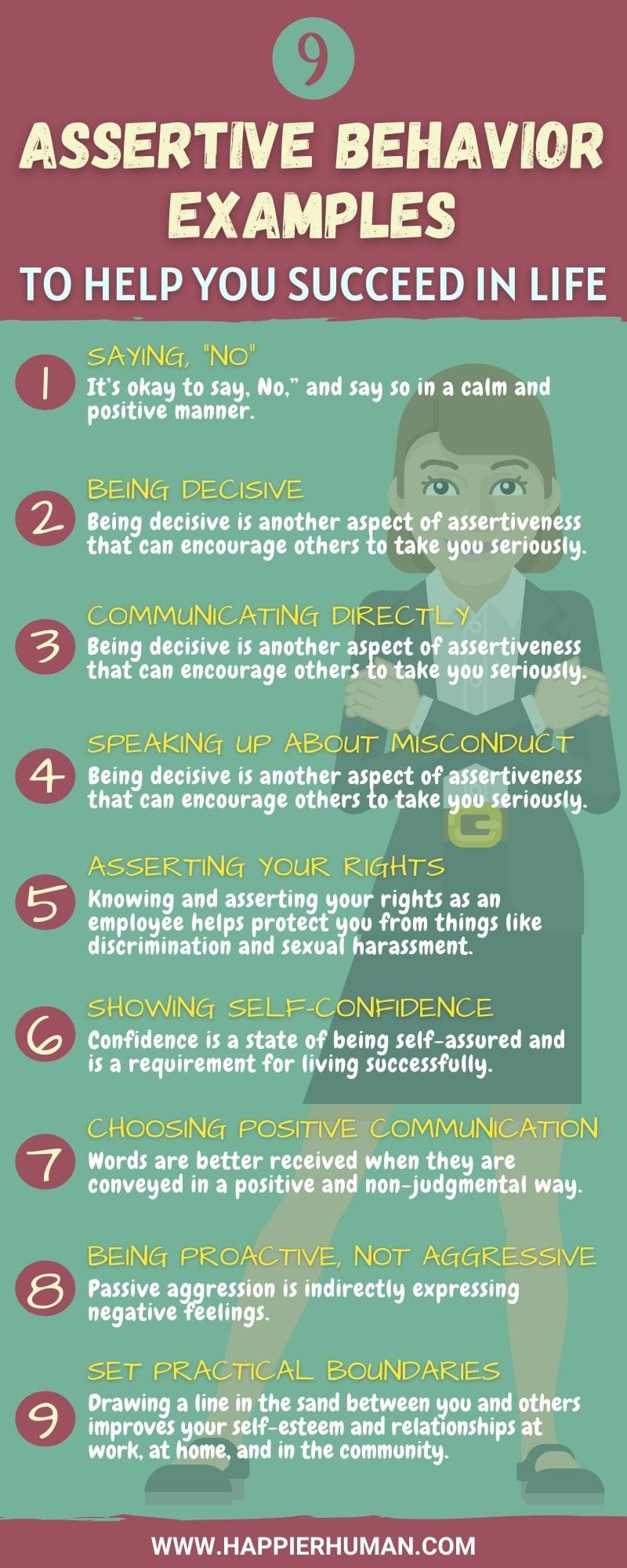Assertiveness is a necessary trait to possess in order to enjoy a positive experience in relationships, at the workplace, and in life as a whole. Incidentally, it isn't a characteristic that comes naturally for everyone, but you can develop and apply it to progress in life.
If you're someone who is shy or afraid to speak up because you don't want to rock the boat or hurt another person's feelings, then this post may be helpful.
You will discover what being assertive entails and walk away with nine assertiveness skills that you can use for success.
What Is Assertive Behavior?
Being assertive is a social communication skill demonstrated by certain behaviors and language of expressing yourself. Those behaviors involve speaking up for yourself in a confident, calm, and respectful manner… as well as setting boundaries.
The skill is essential for helping you express thoughts, feelings, and needs, convey your expectation of being treated fairly and earn respect.
Setting healthy boundaries is a major aspect of assertiveness because it lets people know what you're willing and unwilling to put up with. The practice benefits every aspect of life where another person's action can impact your physical, mental, and emotional well-being.
Establishing boundaries is like a personal manual of rights that you seek to enforce to protect yourself whether it's at work or in relationships. People will quickly realize that you value yourself, time, and energy.
By not expressing to others what behaviors affect us, we open ourselves to being taken for granted, disrespected, violated, and taken advantage of. This can leave us feeling hurt, angry, exhausted, depressed, or resentful towards our boss, coworkers, partner, friends, or family members.
Assertive vs Non-Assertive Behaviors
Sometimes assertive behaviors are confused with non-assertive behaviors. Appropriate tone, being honest and direct, and positive verbal and non-verbal (body language) communication are important aspects of assertiveness.
Below are the three other types of communication styles that do not align with assertive behavior:
Aggressive Behavior
People who use this communication style express their needs and seek to get them met in a way that violates the rights and feelings of others.
Aggressive communicators include narcissists and people who dominate, humiliate, criticize, demand, or threaten. They use “You” statements as a weapon to attack and blame the other person. They also use certain facial expressions and postures to intimidate.
Passive-aggressive Behavior
Individuals using this style appear calm on the surface, but will show their displeasure by acting out behind the scenes. They often feel weak or powerless to confront problems and will resort to subtle ways of getting even.
Passive Behavior
Individuals who engage in passive behaviors do not openly show anger or hurt. They internalize grievances and annoyances and allow them to pile up. An example is saying, “I'm okay,” when you're hurt or angry inside. This often leads to explosive outbursts that are disproportionate to the matter at hand.
9 Assertive Behavior Examples to Help You Succeed in Life
Silencing yourself at work or in relationships can have long-lasting negative effects. That feeling of being invisible or unable to voice your views and concerns can lead to chronic stress, burnout, anxiety, or depression.
By learning these nine behaviors, you'll no longer allow yourself to be overlooked at work for a promotion you deserve or treated unfairly by loved ones. Some people may not like your new approach to communicating at first.
Be consistent (the broken record technique) and they'll eventually learn to accept this as a part of the improved version of you.
1. Saying, “No”
People-pleasing may seem like a good trait to have, but it leads to burnout and resentment because it often requires putting the needs of others ahead of yours. I used to be a people-pleaser.
Being that person led to caregiver burnout and being mad at myself for saying, “Yes,” when I clearly should have declined. I was left feeling overwhelmed, stretched thin and regretful.
If you engage in people-pleasing, you may find yourself doing less than ideal things or favors for your boss or friend, but remain passive to stay in their good graces.
It's okay to say, No,” and say so in a calm and positive manner.
There's no need to explain your refusal to carry out a request, especially if it's one that is outside your job description or doesn't align with your values.
If this situation arises with a friend, you can use the opportunity to suggest doing something you're actually interested in or enjoy doing. Fair and respectful friends will be open to your suggestions and preferences.
2. Being decisive
Being decisive is another aspect of assertiveness that can encourage others to take you seriously. I can think of times someone seemed to not know what they really wanted to do or achieve.
Their action came across as a lack of confidence and doubt in their abilities. I also used to overthink things and flip-flop on decisions.
Realize that these characteristics open you up to being taken advantage of by a manipulative partner, family member, or friend. Say what you mean and mean what you say by acting in ways that do not go against the stance you took.
Making decisions quickly and effectively also benefits you in the workplace. You're able to stay organized and there's less procrastination, increased performance, and greater productivity.
These are factors for career success. It also makes you a better leader and can position you for a promotion to team leader, supervisor, or manager.
If you often struggle to make an important decision or frequently overthink the choices you have to make, then you might be with “analysis paralysis.” Watch the video below to learn about the 7 actionable strategies you can use to overcome this mindset.
3. Communicating directly
Articulating your needs should be positive and proactive instead of passive or aggressive. People tend to take a passive approach as a way of avoiding conflict. However, it can be counterintuitive. Address a matter head-on. Talking around the issue can lead to confusion about your needs or feelings or what you expect from others.
An example of indirect or passive communication is saying, “Wouldn't it be better if we waited until tomorrow?”
The question leaves room for the other person to disagree, leaving you in a position to show displeasure or counteract to get the desired outcome. Instead, you can say, “I really don't feel like going today.” Notice the use of the “I” statement. It shifts the focus onto your needs without attacking or accusing the other person.
Passive behaviors force you to have to go along with the decisions of others and leave you feeling miserable or unhappy.
In effect, your mind says, “no,” but your actions contradict what you truly want. People will realize you don't think your thoughts and feelings are important and may use that to disregard your wants and needs.

4. Speaking up about misconduct
You cannot control the behavior of others. As such, there will be times they will do things that will make you feel violated. It could be anything from deception and stealing to cheating and abuse. If you don't say something, it's likely that the offending person will continue with their behavior.
Millions of people are living in abusive situations or experience sexual harassment in the workplace but remain silent. It doesn't mean they like it. Perhaps somewhere along the line, they were made to feel their opinions and feelings don't matter.
Chances are they haven't learned assertive techniques to speak up about misconduct or were led to believe the myths about assertiveness. In other cases, people are fearful of the consequences, whether it's losing a relationship, their children, job, connection, or a certain lifestyle.
Recognize your value and love yourself enough to say, “STOP” or disengage from situations where you're mistreated.
5. Asserting your rights
This is especially valuable for establishing legal and ethical boundaries in the workplace. Knowing and asserting your rights as an employee helps protect you from things like discrimination and sexual harassment. Some important rights/laws include the right to fair pay, paid overtime, leave to recover from illness and protection against retaliation.
It's possible your employer or boss is not acquainted with all of your employee rights and may negligently infringe them. Letting your employer know you're familiar with your rights may educate them at the same time.
Remember there are rules on the proper approach. Remain calm and respectful and avoid accusations when discussing any potential violation of your rights as an employee or individual in the workplace.
Stating your rights can sometimes lead to positive changes in workplace policies and a better working environment for all.
6. Showing self-confidence
When you are confident, you're able to stand up for yourself, your loved ones, and for what is right with ease.
Confidence is a state of being self-assured and is a requirement for living successfully. Self-confident people typically have healthy self-esteem. They know their worth and believe in themselves and their capabilities. Note that cockiness and arrogance are not signs of confidence.
Your confidence when expressing a need or asserting a right causes people to listen to you. One reason is, your beliefs about yourself influence how the world interacts with you. You take criticism with ease, are willing to acknowledge your mistakes and work on self-improvement.
Having healthy self-confidence has numerous benefits that go beyond the ability to stick up for yourself. It helps you succeed by keeping you self-motivated to set and achieve goals. You're also more open to the opposing beliefs of others and handle stress and conflict more effectively.
7. Choosing positive communication
Words are better received when they are conveyed in a positive and non-judgmental way. The right choice of words and a calm, friendly tone of voice encourage others to value what you say. Some communication experts call it being “tactful,” and should be balanced with directness.
Practicing tactfulness is particularly important when you have to say something that is negative or difficult to express.
Common examples include when you want to talk about a problem, disagree, have an opposing viewpoint, or are about to say something the other person will not like. Say, “I disagree,” if you disagree, instead of, “What kind of stupid idea is that?”
If you feel it's something important that needs to be said to your manager, spouse, or colleague, then say it. That's the only way to try and get the desired outcome.
Choose to express things in a way that allows for an honest and open conversation. Maintain eye contact and actively listen to the other individual (assertive body language).
It's all helpful to choose the appropriate time and setting to address a problem. Using positive language to communicate shows that you're considerate of the other person's feelings.
8. Being proactive, not aggressive
An assertive style of communication allows you to pre-empt a situation that may not be in your favor and take steps to positively influence the outcome.
There is no need to behave aggressively toward the other person when stating your rights, setting a boundary, or attempting to get your needs met. It can be tempting to approach a problem using passive or passive-aggressive behaviors, but that isn't helpful either.

Passive aggression is indirectly expressing negative feelings. It can involve making mean statements or acting a certain way hoping that the other person will figure out your needs or feelings. The goal here is to create the best outcome for you without crashing someone else's boundary.
9. Set practical boundaries
Staying silent when you should speak up, set, or enforce a boundary may earn you the title, “Mr. Easy-Going” or “Miss Nice.” Meanwhile, you're furious and resentful inside because people take your kindness for weakness and try to walk all over you.
Make a decision to start setting healthy and practical boundaries while remaining kind. For example, if you allow loved ones to text or call you anytime, day or night, it starts to feel intrusive. Respectfully request they phone you within a certain time range unless it's an emergency.
Drawing a line in the sand between you and others improves your self-esteem and relationships at work, at home, and in the community.
Here's an example of boundary setting at work in a skillful and tactful way:
Your boss has a habit of piling work on your desk without asking about your current work capacity or ability to tackle additional projects. Chances are, they aren't trying to purposefully overload you.
They just know you're a high-performer who's dependable. While it's good to be recognized as a valuable employer, overtaxing you is taking advantage of your willingness.
Resist the temptation to lose your cool or demand change. An assertive response would be to request a meeting with your boss to address the practice. You can respectfully propose a system of sharing the workload in a more equitable manner.
It's helpful to note that standing up for yourself isn't a one-sided affair. While you're focused on articulating your wants and needs to your employer, it's fair to balance them with the needs and expectations of the company.
Final Thoughts on Assertive Behaviors
By using assertive techniques, you can speak up for yourself (and others)… share opinions, disagree respectfully and hold firm boundaries. It may take daily practice before it becomes second nature to you. That’s ok.
One thing is sure, you will no longer have to stew in displeasure to make others happy. As you work on improving assertive communication, you may feel more confident about yourself. That's the feeling you get when you recognize your value and take steps to protect your well-being.
If you're interested in more articles like this one, 5 Levels of Communication for Your Interpersonal Relationships is another post you may enjoy reading. And feel free to add to our comments section with personal anecdotes and experiences.
Finally, if you want to increase your happiness and life satisfaction, then watch this free video that details the 7-minute habit for planning your day to focus on what's important.


